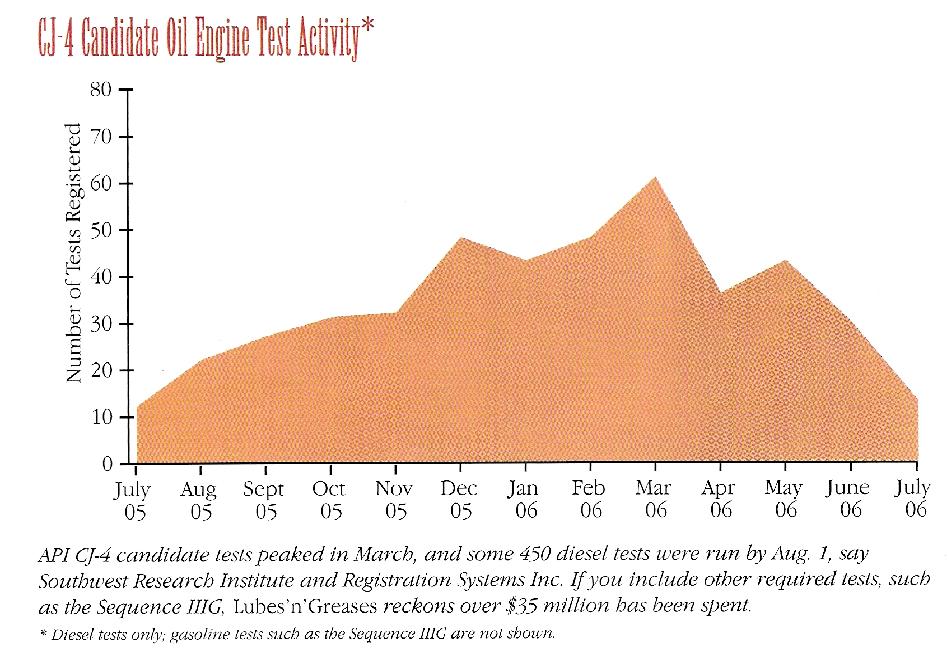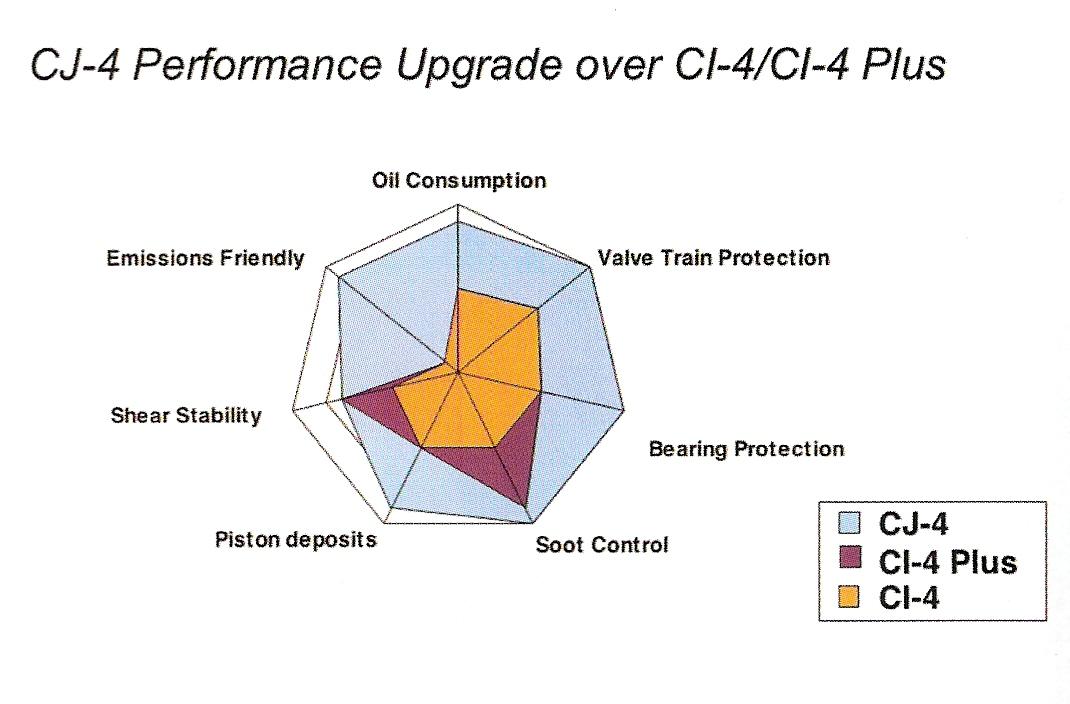As Reported in Lubes'N'Greases October 2006 Vol. 12 Issue 10 by David McFall
CJ-4 Gets Rolling

How good is it?
"CJ-4 is the most robust API oil category ever developed in the U.S.," asserts Jim McGeehan of Chevron Global Lubricants, chairman of the ASTM Heavy Duty Engine Oil Classification Panel where the new specification was hammered out. His group began work on CJ-4 in September 2002 and completed it this past January, after accepting five new engine tests and setting limits for a total of nine fired engine tests and six bench tests. Even as that work was under way, McGeehan acknowledged the difficulty of getting a new quality upgrade through the ASTM developmental process - where forward motion is always balanced on a knife-edge with energy-sapping slowdowns. Firm timelines had been imposed by diesel engine manufacturers, and if the ASTM panel couldn't produce the upgrade on time, Shank had forewarned, EMA would simply bypass McGeehan's panel and complete the upgrade outside of ASTM.
So early on, McGeehan adopted a five-word motivator for his Panel: "We will deliver on time." Over the course of the new oil's development, he recited this mantra at least once in every meeting, often multiple times.
And that is just what happened. Under McGeehan's prodding and guidance, the ASTM panel produced CJ-4 in time to coincide with the introduction of the 2007 model year engines.
Was it worth it?
Dale Carroll is North American heavy-duty product manager at additive supplier Lubrizol Corp., which participated throughout the ASTM effort. His company, he said, "very strongly supports the new API CJ-4 category and has invested significant financial and human capital in making this specification a reality As a performance category, CJ-4 is the most comprehensive, robust and expensive upgrade I have seen in my 20-plus years in the business.
"The new oils improve valve-train protection, keep modern diesel engine pistons cleaner, control oil consumption better, and enhance protection against soot-related viscosity thickening. Just as importantly they enable the required emissions reductions brought about by after treatment devices and ultra-low sulfur diesel fuel."
Carroll cautioned however, "At this point in time it is probably too early to tell whether or not CJ-4 has been worth it. That will depend on how quickly the market upgrades to the higher-performing CJ-4 lubricants, whether or not the OEMs continue to stand behind this upgrade as they have done so far, and to a very great degree on the longevity of this category.
"If we find that six to 18 months from now we need a CJ-4 supplemental category, then clearly it will not have been worth the effort."
ExxonMobil's Steve Kennedy co-chaired the Diesel Engine Oil Advisory Panel, which along with the ASTM panel was centrally involved throughout CJ-4's development. From the oil giant's perspective, Kennedy said, "the key industry working groups have done an outstanding job developing the new CJ-4 category and delivering it on time. This new category balances the need for strong engine performance while still taking exhaust after-treatment durability into account through the use of compositional restrictions. The extensive engine and bench test requirements in CJ-4 define a very high level of performance exceeding earlier API categories in several key areas, such as valve-train wear and piston deposit protection in particular." Kennedy added that developing and launching a comprehensive specification like CJ-4 could not be achieved without "excellent cooperation from all industry stakeholders. ExxonMobil continues to support the activities that enable the development of balanced, technically sound standards. We believe that having the systems in place to do this type of work is in the best interest of all involved parties."
OEM's happy at last?
Greg Shank co-chairs the Diesel Engine Oil Advisory Panel with Kennedy; and chairs EMA's Lubricants Committee. He has been acutely aware of the critical importance of this quality upgrade and its deadline. "EMA views CJ-4 and its development as a significant success," he said. "EMA's improved performance requirements were met and a chemical box was defined for after treatment compatibility. In addition, backward compatibility for legacy engines was achieved."
Shank too injected a note of caution: "We will not know if the chemical box is correct for after treatment until oils and engines are in the field for a year. In addition, a Turbo Charger Deposit Test is not currently available and we will need one for engines with closed crankcase ventilation."
He concluded, "Cooperation of all stakeholders was excellent and the category was delivered on time. EMA is appreciative of and thanks the oil and additive industries."
FAQ's on the New Category
 The Following are some of the points prepared by the
American Petroleum Institute, answering frequently asked questions on it's
new CJ-4 heavy-duty diesel oil category.
The Following are some of the points prepared by the
American Petroleum Institute, answering frequently asked questions on it's
new CJ-4 heavy-duty diesel oil category.
Q. Do engine manufacturers recommend use of API CJ-4 oils to protect 2007 emission-controlled engines?
A. Yes, API CJ-4 oils, used in engines running on ultra-low sulfur diesel (ULSD) fuel, are critical for the durability and performance of 2007 and newer engines that utilize advanced emission control technologies. These oils have been subject to the most severe qualification testing requirements of any API engine lubricant category API CJ-4 oils are designed to meet the expectations of the engine manufacturer and the customer in terms of both engine performance and maintenance intervals.
Q. How does the performance of API CJ-4 oils differ from previous categories like API CI-4 or API CI-4 PLUS?
A. API CJ-4 oils have additive systems specially designed to improve the protection of both the engine power system and advanced emissions control systems like diesel particulate filters (DPFs). Use of these new oils will help maintain the life of the emission control system as required for regulatory compliance. API CJ4 oils are formulated for improved wear protection, deposit and oil consumption control, soot-related viscosity control, prevention of viscosity loss from shearing, used oil low-temperature pumpability, and protection from thermal and oxidative breakdown when compared to previous API performance categories.
Q. How does the use of API CJ-4 oils impact my oil drain intervals?
A. Specific oil drain recommendations vary widely depending on engine type, duty cycle, fuel type and other factors. As always, users should seek guidance from their engine or vehicle manufacturer regarding specific service recommendations.
Q. Do I need to adjust my used oil analysis program for API CJ-4 oils?
A. Yes, API CJ-4 oils may have a different fresh oil chemical profile from previous oils because one of the key requirements of the API CJ-4 category is the setting of maximum limits on the phosphorus, sulfur and sulfated ash content of oils. These limits are needed to protect the new 2007 advanced emission control technologies. Users should seek guidance from their oil supplier and/or engine or vehicle manufacturer regarding any changes to used oil analysis programs for API CJ-4 oils.
Q. Do API CJ-4 oils protect older engines as well as API CI-4 or API CI-4 PLUS oils?
A. Yes, API CJ-4 oils are designed for use in new engines as well as the existing on-highway fleets. API CJ-4 oils are qualified utilizing several new engine tests that are more severe than those used for API CI-4 or API CI-4 PLUS oils thus defining a new category of oils with much more robust performance than previous categories. API CJ-4 oils are formulated for improved wear protection, deposit and oil consumption control, soot-related viscosity control, prevention of viscosity loss from shearing, used oil low-temperature pumpability, and protection from thermal and oxidative breakdown when compared to previous API performance categories. As always, users should seek guidance from their engine or vehicle manufacturer regarding specific service recommendations.
Q. Do API CJ-4 oils protect older engines if they are operated on 500 ppm maximum sulfur fuel?
A. Yes, API CJ-4 oils are designed to have performance
benefits over API 0-4 and API CI -4 PLUS oils when using both 15 ppm and 500 ppm sulfur fuel, and qualification testing is conducted using both fuels. As a reminder, 2007 on-highway engines with advanced emissions systems must use ultra-low sulfur diesel fuel containing 15-ppm sulfur or less. In cases where older engines/vehicles are operated with 500 ppm sulfur fuel, API CJ-4 is designed to protect the engine better than API CI-4 and API CI-4 PLUS. As always, users should seek guidance from their engine or vehicle manufacturer regarding specific service recommendations.
Q. Can API CJ-4 oils be used in off-highway applications?
A. API CJ-4 oils can be used in off-highway applications. However, the use of API CJ-4 oils with higher sulfur fuels, like those generally provided for off-highway use that may contain up to 5,000 ppm sulfur, may result in revised oil drain intervals and other maintenance recommendations. As non-road fuel sulfur levels are reduced, first to 500 ppm in June 2007 and then to 15 ppm in June 2010, manufacturer recommendations may be revised.